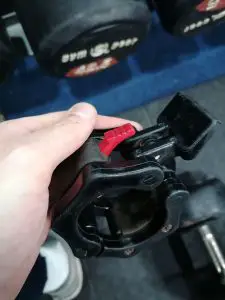Does this sound familiar – You’re midway through an exercise, it starts to get difficult, and suddenly you feel the weight plates are loose on the dumbbell and your collar has come loose? This is likely going to be the issue for those using a spinlock collar.
Home gym enthusiasts will be familiar with this issue, especially if you are new to weight training and have a cheap set of spinlock dumbbells…
Spinlock collars are a solid option for keeping weight plates on the bar, but they are not necessarily the tightest and most secure option available. In fact, they have an irritating habit of coming loose. Therefore, we’re going to cover how to stop spinlock collars coming loose on dumbbells below. It’s an annoying issue but one with some easy fixes.
Why Do Spin Lock Collars Come Loose
In general, spinlock dumbbell collars are one of the safer and more secure methods for holding weight plates in place on a dumbbell or barbell. They aren’t the tightest method, but they will definitely do a good job of stopping plates from falling off during an exercise.
Check out this guide on barbell collar necessity to see which type of collar you need.
The reason is that they need to be spun on the dumbbell threading to secure them in place. You can’t push them on like you can with a spring locking collar. This means that if you can’t push them on, a weight plate also can’t push them off making them a solid and safe option.
While they can’t necessarily be pushed off the handle, there is one big issue with spinlock collars and that is when they come loose during an exercise. My first set of dumbbells was a York vinyl set which featured a plastic handle to cover the bar and a plastic set of spinlock collars.
I didn’t know any better at the time but these collars simply wouldn’t stay tight no matter what I did. It didn’t bother me then but I now understand the frustration of collars rattling loose when you are trying to focus on moving some relatively heavy weight!
The main reason why spin lock collars come loose is that they don’t have any grip between the bar and weight plates. If all of your equipment is metal (iron/steel) then this doesn’t create an opportunity for anything to grip.
Metal on metal is not a material combination that holds items together firmly. It can do, but this is one of the key reasons why when you are using nuts and bolts you also need to use a washer. This is something that acts as a barrier and stops items that can spin from spinning.
The same concept is true with spinlock collars, if something can spin in one direction but isn’t locked into place firmly, it can easily spin in the reverse direction. This is exactly what happens with spinlock collars on dumbbells and barbells which have moving parts and are the primary reason why they come loose.
How to Stop Spinlock Collars Coming Loose
While loose spin lock collars can be a serious frustration for many lifters, there are some simple solutions you can use to stop these collars from coming loose.
1) Ensure Rubber Inserts are in Place
Firstly, metal on metal does not provide a solid seal to keep two items locked into place. Any movement (like during exercise) will cause these plates to shake loose as there is not enough friction to keep them locked in place.
This is where rubber O-rings are used. Most spin lock collars should come with a rubber ringer inserted on the inside of the collar (the side which screws against the weight plates). This provides both suction and grip to keep the collar held tightly and firmly once screwed in.
Further to this, the dumbbell handle should also have a rubber insert positioned on the barbell collar clamp
This acts as a washer between the weight plate and the dumbbell handle to again, increase friction and prevent the plates from slipping and moving during use. If you are missing one or both of these rubber inserts/washers, then this should be your first step to rectifying loose spin lock collars.
2) Thread the Dumbbell
If you have the above solution in place, the next step you can use is to thread the dumbbell sleeves with some tape. That may sound like a confusing sentence, but it’s related to the parts of a dumbbell.
The section of the dumbbell on which you put the weight plates is known as the dumbbell sleeves, these are also the part that the spinlock collar spins on. We keep coming back to this point but this is a further point of metal on metal contact and wherever this can be reduced, you’ll see a comparable reduction in looseness.
By wrapping some medical, physio, or paper tape around the sleeves – essentially following the thread line, you’ll add a layer of friction without impacting how easily the plates can be loaded onto the bar. For a demonstration of this, check out the video below:
Medical tape is considered to be the best option for this so we’d recommend using this product to test it out yourself.

3) Use Extra Spin locks
If nothing else seems to work and your dumbbells still keep spinning loose during use, a final method can be to double up on spinlocks or add an additional type of barbell collar. If a spinlock collar doesn’t keep the weight in place, it can certainly do a job of keeping the original spinlock in place!
A second spin lock collar will add another layer of tightness and friction to prevent a spinlock collar from coming loose during an exercise. These usually come loose because the movement of an exercise combined with metal on metal contact between the collar, plates, and dumbbell bar all have minimal friction and grab.
Therefore, adding a second collar (which is admittedly quite tedious when changing weights) is a last resort solution that you can use.
4) Use a Locking Collar
As a bonus tip, most people don’t like spinlock collars and they are not entirely necessary. You could use a locking collar in its place. These collars have a fastening clamp and if you get a relatively high-quality option, there’s very little chance of them moving during use.

Our recommendation would be the Lock-Jaw PRO 2 Barbell Collar with Magnets but that’s only if you’ve tried all of the above and nothing has worked.

Final Thoughts
There are few things more frustrating when training at home than when your spinlock collars keep coming loose. This makes it harder to perform certain exercises and also gives you serious anxiety that the plates are going to fall off mid-lift when you could be in a very precarious position (like with your head directly underneath).
Fortunately, there are some simple solutions to stop spin lock collars from coming loose on a dumbbell. These solutions are:
- Ensure the spinlock collar and dumbbell handle both have a rubber o-ring or rubber washer in place
- Wrap the dumbbell sleeve with medical tape to increase friction
- Add a second spin lock collar to either side of the dumbbell (a spring collar will also work)
If none of these solutions work, it might be time to upgrade to a fixed weight dumbbell set!

